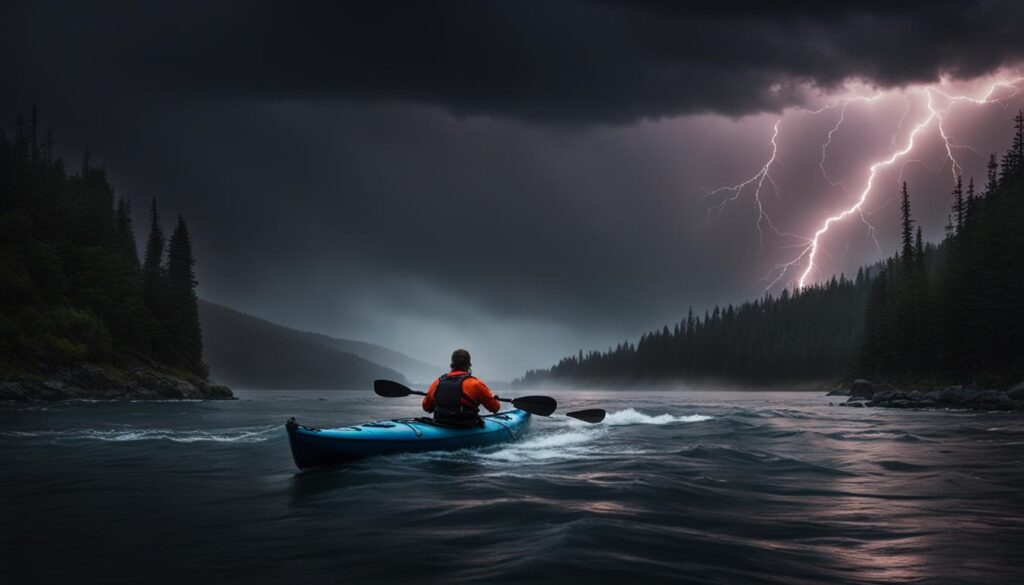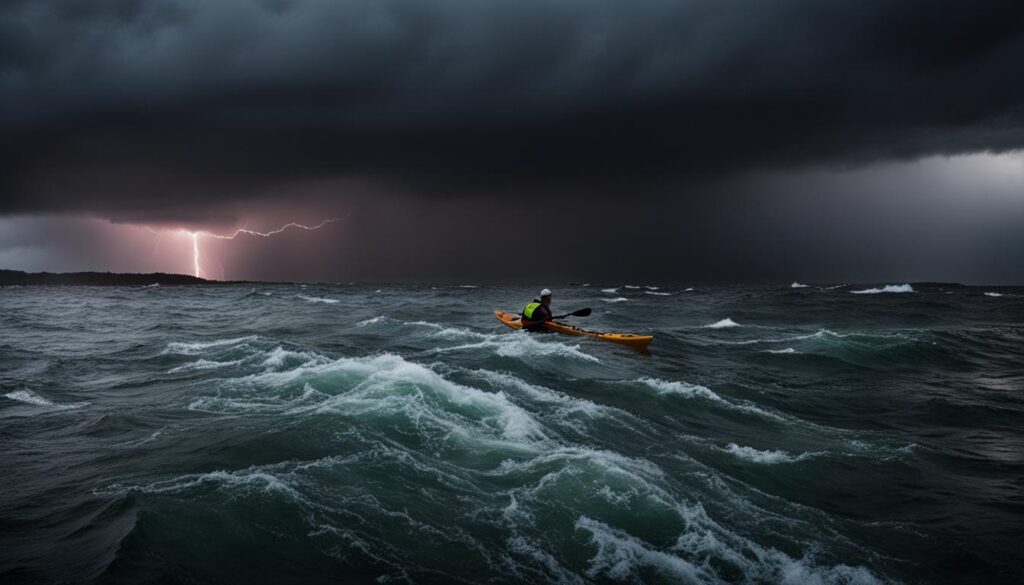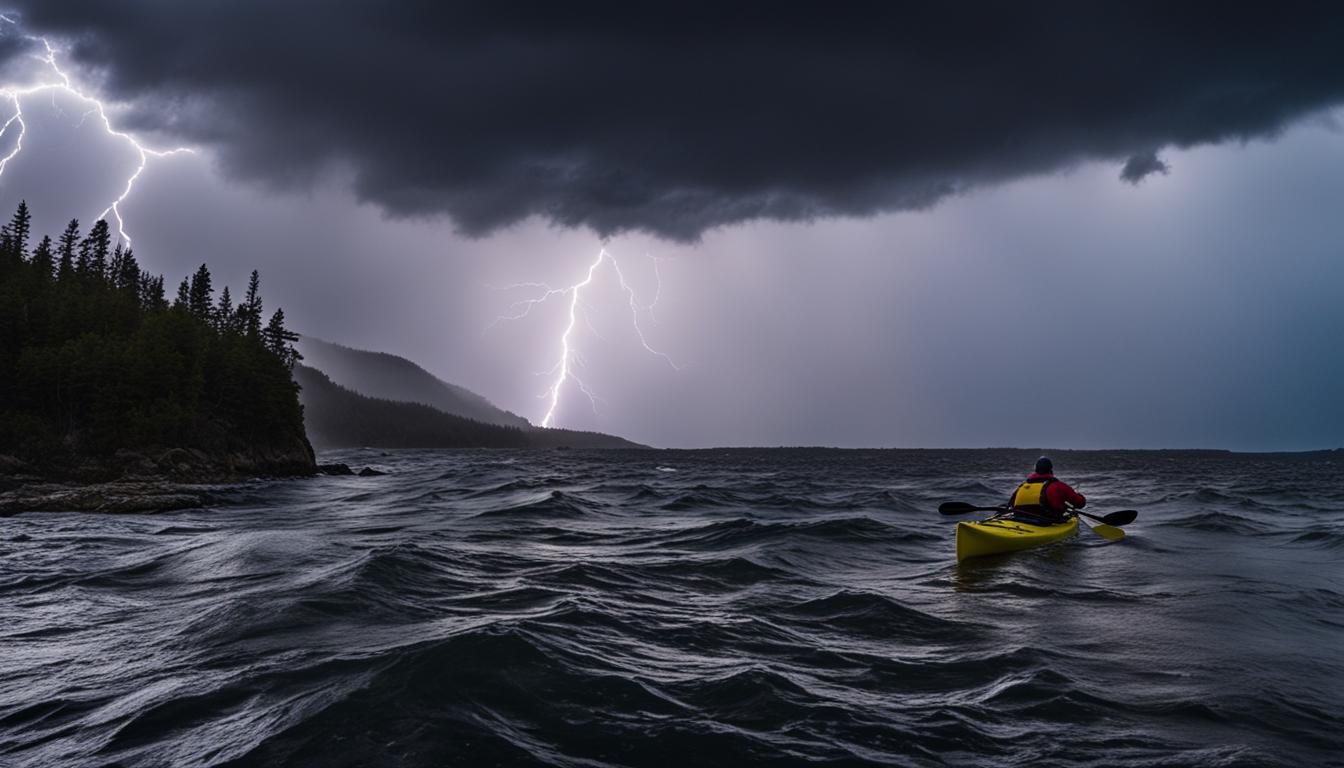Kayaking is an exciting outdoor activity that allows you to explore the beauty of waterways. However, it’s essential to be aware of the potential risks, especially when it comes to lightning. Thunderstorms can pose a significant danger to kayakers, but by following proper safety protocols, you can ensure your well-being during kayak trips, even in unpredictable weather.
Key Takeaways:
- Understanding the risks of kayaking in thunderstorms is crucial to your safety.
- Lightning poses a significant threat to kayakers due to their exposure on the water.
- Precautionary measures such as checking the weather forecast, wearing appropriate gear, and knowing emergency measures can help mitigate the risks.
- Researching local weather conditions and hazards is essential before planning a kayaking trip.
- Plan a trip within your capabilities and share a float plan to ensure someone knows about your itinerary.
Understanding the Risks of Kayaking in Thunderstorms
Kayaking in thunderstorms can be an extremely thrilling experience, but it’s important to be aware of the risks involved. The primary risk is the increased potential for lightning strikes. When you’re out on the water, you become more exposed to the dangers of lightning. Therefore, it’s crucial to understand the hazards associated with kayaking in thunderstorms to ensure your safety.
Some of the risks you may encounter while kayaking in thunderstorms include the possibility of getting struck by lightning, rapidly rising river levels, flooding and debris, cold water injuries, drowning, high waves and strong currents, and flash floods. It’s essential to recognize these risks and take the necessary precautions to avoid them.
Remember, your safety should always be your top priority. By understanding the potential risks of kayaking in thunderstorms, you can make informed decisions and take appropriate measures to protect yourself. Now, let’s explore some precautionary measures you can take to ensure your lightning safety while kayaking.
Precautionary Measures for Lightning Safety While Kayaking
When kayaking in areas prone to thunderstorms, it is crucial to follow certain precautionary measures to ensure your safety. By being prepared and taking necessary steps, you can minimize the risks associated with lightning. Here are some emergency measures for lightning kayaking:
- Check the weather forecast: Before heading out on your kayak trip, always check the weather forecast. Pay attention to any thunderstorm warnings or signs of imminent electrical storms. If severe weather is predicted, it’s best to reschedule your trip for another day.
- Be prepared with appropriate gear: Ensure you have the necessary gear to protect yourself in case of lightning. This includes a waterproof kayaking jacket and pants, gloves, hat, booties, life jacket, and a spray skirt. Wearing synthetic materials will help you stay dry and comfortable.
- Increase visibility: Wearing bright colors and attaching a flag to your kayak will increase your visibility to others, reducing the risk of collisions.
- Know your route and potential hazards: Familiarize yourself with the route you plan to take and any potential hazards along the way. This will help you make informed decisions and avoid dangerous areas.
- Trust your gut: If something doesn’t feel right, trust your instincts and don’t go out on the water. Your safety should always be a top priority.
In addition to these measures, it is important to know what to do in case your kayak flips over. Remember to immediately get off elevated areas, reduce your surface area by crouching down, stay away from objects that conduct electricity, and seek shelter for at least 30 minutes after the last sound of thunder.
Another useful tool for kayakers is a lightning detection device. These devices can help you monitor the presence of lightning in the area and make informed decisions about whether to continue your trip or seek shelter. Having this information can greatly enhance your safety while kayaking in areas prone to electrical storms.

Table: Essential Gear for Lightning Safety While Kayaking
| Gear | Description |
|---|---|
| Waterproof kayaking jacket and pants | Protects you from getting wet during a thunderstorm. |
| Gloves | Provide grip and protect your hands from blisters. |
| Hat | Keeps your head dry and shields your eyes from rain. |
| Booties | Protect your feet and keep them warm while paddling. |
| Life jacket | Essential for safety and flotation in case of emergencies. |
| Spray skirt | Keeps water from entering your kayak and keeps you dry. |
Kayaking near Thunder: Assessing the Lightning Strike Risk
When planning a kayaking trip, it is crucial to understand the risk of lightning strikes in the area you’ll be paddling. Thunderstorms can develop quickly, and being caught on the water during an electrical storm can be extremely dangerous. To ensure your safety, it’s essential to research the local weather conditions and assess the lightning strike risk before embarking on your adventure.
You can start by checking the weather forecast for thunderstorms or lightning activity. There are various reliable weather apps and websites that provide up-to-date information about lightning strikes in specific areas. Be mindful of any thunderstorm watches or warnings issued by local authorities, as they indicate a higher risk of lightning. If the forecast indicates a possibility of thunderstorms, it’s best to postpone your kayaking trip for another day.
In addition to checking the weather forecast, it’s important to gather information about the geographic region you’ll be kayaking in. Some areas may have a higher frequency of thunderstorms or be more prone to lightning strikes. Researching local lightning strike patterns and historical data can give you valuable insights into the level of risk you may encounter. This information can help you make informed decisions about whether it’s safe to proceed with your kayaking plans or if it’s best to choose an alternative location.

Table: Lightning Strike Risk Assessment
| Factors | Lightning Strike Risk |
|---|---|
| Geographic location | High risk areas: Coastal regions, mountainous areas, open fields |
| Time of year | Higher risk during warmer months and peak thunderstorm season |
| Time of day | Higher risk during late afternoon and early evening |
| Topography | Higher risk in areas with tall trees, cliffs, or elevated terrain |
| Weather conditions | Higher risk during unstable atmospheric conditions and when thunderstorms are present |
By researching the local weather and considering the specific factors that contribute to lightning strike risk, you can make informed decisions about whether it’s safe to go kayaking. Remember, your safety should always be the top priority. If there’s any doubt or concern about the potential for lightning strikes, it’s best to err on the side of caution and postpone your kayaking adventure to a safer time.
Plan a Trip Within Your Capabilities and Share a Float Plan
When it comes to kayaking in thunderstorms, one of the most important aspects of ensuring safety is planning a trip that aligns with your capabilities. Assess your skills, paddling abilities, and comfort level to choose a trip that you can handle with ease. If you’re new to kayaking or uncertain about your abilities, it’s advisable to start with guided trips or take classes to improve your skills before venturing out on unguided trips.
Creating a float plan is another crucial step in promoting kayak lightning protection and overall safety. A float plan involves sharing your trip details with a reliable person, such as the planned route, put-in and take-out locations, launch and return times, and an action plan in case you’re out past the planned timeline. By sharing this information and keeping copies in your vehicle and kayak, you ensure that someone knows about your whereabouts and can take appropriate action if necessary.
Remember, planning a trip within your capabilities and sharing a float plan are key steps in prioritizing your safety and enjoying your kayaking adventures with peace of mind.
Table: Importance of Planning and Float Plans
| Importance | Benefits |
|---|---|
| Planning a trip within your capabilities |
|
| Sharing a float plan |
|
Conclusion
Kayaking in the rain or during thunderstorms can be an exhilarating experience, but it’s important to prioritize safety. By understanding the risks associated with lightning and taking precautionary measures, you can mitigate the dangers and enjoy your trips safely.
Checking the weather forecast before heading out and wearing appropriate gear, such as a waterproof kayaking jacket and pants, gloves, hat, booties, life jacket, and a spray skirt, are essential for kayak lightning protection. Increasing your visibility by wearing bright colors and attaching a flag to your kayak can also help prevent accidents.
Knowing your route and potential hazards, trusting your instincts, and being prepared for potential emergencies are all vital steps to avoid lightning while kayaking. Remember to always prioritize safety and have fun while exploring the waterways!
FAQ
Can I go kayaking in thunderstorms?
It is highly recommended to avoid kayaking in thunderstorms. The increased risk of lightning strikes poses a significant danger to kayakers.
How can I stay safe from lightning while kayaking?
To ensure lightning safety while kayaking, it is important to follow precautionary measures such as checking the weather forecast, wearing appropriate gear, increasing visibility, knowing your route, and trusting your instincts.
What should I do if I get caught kayaking in a thunderstorm?
If you find yourself kayaking in a thunderstorm, it is important to immediately seek shelter off elevated areas, reduce your surface area by crouching down, stay away from objects that conduct electricity, and wait at least 30 minutes after the last sound of thunder before continuing your trip.
How can I monitor the presence of lightning while kayaking?
Lightning detection devices can be useful for kayakers to monitor the presence of lightning in the area and make informed decisions about continuing their trip.
Is it important to research local weather and hazards before kayaking?
Yes, it is crucial to research the local weather conditions and hazards before kayaking. This includes checking the weather forecast and updates while paddling and gathering information about local hazards such as strong winds, tricky currents, unexpected swells, and underwater hazards.
What should I do if I want to go kayaking during a thunderstorm?
It is strongly advised not to go kayaking during a thunderstorm. It is best to reschedule the trip for another day when the weather is clear and safe.
What is a float plan?
A float plan is a document that includes your trip details, such as the planned route, put-in and take-out locations, launch and return times, and an action plan in case you’re out past the planned timeline. It is important to share the float plan with a reliable person and keep copies in your vehicle and kayak for reference.





